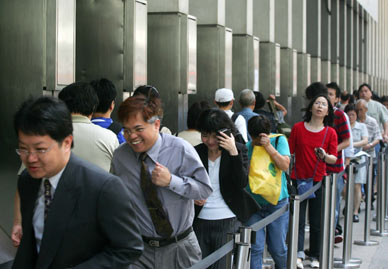Office worker Carol Au scurried out of the Bank of China's dazzling
skyscraper in central Hong Kong with a subscription form to buy shares in the
bank's US$9.9 billion (euro7.75 billion) initial public offering -- which could
wind up being the world's biggest IPO in six years.

Local
residents queue to take prospectuses for the initial public offering of
Bank of China in Hong Kong May 18, 2006.
[Reuters] |
The 28-year-old was like hundreds of
thousands of other Hong Kongers who flocked to bank branches during the past
week to pick up forms for the June 1 listing on Hong Kong's stock market. They
are ready to bet that the No. 2 bank in China's booming economy will be a great
investment.
But Au was also aware of the risk of the investment.
"I'll just be buying a little bit at first so it's not too risky," Au said as
she rushed off to work clutching the bank's prospectus, as thick as a big city's
telephone book.
One of the factors feeding the frenzy for Bank of China shares is the
remarkable success of two other big Chinese lenders that had IPOs in Hong Kong
last year.
The share price for China Construction Bank, the nation's No. 4 lender, has
shot up 50 percent since its IPO in late October. Bank of Communications, the
fifth-largest, has nearly doubled since it hit the market in June.
Agnes Deng, investment director at Standard Life Investments in Hong Kong,
said the banks look like a good long-term investment.
"Bank of China will benefit from financial reform in China and will benefit
from the consumer loan growth as well as benefit from a lot of the foreign
investment coming into China," she said.
Launching IPOs for state-owned banks in overseas capital markets is key to
China's plan to reform its financial system. For decades, the big banks have
been plagued with poor governance and bad loans to clunky state-owned
enterprises.
To prepare the lender for its IPO, the government pumped US$22.5 billion
(euro17.6 billion) into the bank to clean up bad loans. The bailout reduced the
bank's non-performing-loan ratio to 4.4 percent in mid-2005, from 33.41 percent
in 2003, Fitch Ratings said.
At a recent news conference that served as a big pitch for the IPO, the
bank's leaders briefly acknowledged that the institution has had troubles. But
they said the bank's history, mammoth size and reform efforts gave it the
brightest future.
"Bank of China has gone through a lot in the past few years. I would just
describe our current IPO process as being at the right place at the right time,"
chairman Xiao Gang said at a video conference in which his image was projected
on a huge white map of the world.
The bank is China's oldest, founded in 1912. The bank's Hong Kong skyscraper
-- designed by world renowned architect I.M. Pei, whose father worked for the
bank -- is one of the world's most stunning buildings, with its diagonal cross
braces, triangular shapes and glass roofs.
Li Lihui, the bank's chief executive officer, told reporters in Hong Kong
that the lender was the leader in many of the fastest-growing businesses.
"Over the past two years, we accounted for approximately one-third of the new
mortgage loans. We were the first and are the largest credit card issuer with a
market share of 24 percent," Li added.

Residents line up to take a copy of the prospectus for the initial
public offering of Bank of China in Hong Kong May 18, 2006.
[Reuters] |
And he said there is plenty of room to grow as the world's most populous
nation grows more affluent. He noted that there are only two credit cards per
100 Chinese, while in America there are 200 cards per 100 people.
"Bank of China is at the center of this personal banking boom," Li added.
But the bank will have some serious competition by the end of this year when
China opens up its banking sector to foreign lenders, like HSBC Holdings PLC and
Citigroup Inc.
Amid the hoopla of Bank of China's IPO, there are those who point out that
risks are still lurking. A report by Lehman Brothers recently questioned whether
the bad loan problem has been fixed.
The report by Rob Subbaraman and Wenzhong Fan said that government bailouts,
IPOs and restructuring do not necessarily improve management and lending
behavior.
But these concerns probably won't scare off many investors, said Howard
Gorges, vice chairman of South China Brokerage.
"People are not expecting to buy perfection, as long as they feel there's an
improving trend underway, given the size of the Chinese economy and the scope of
Bank of China within that. They're buying a piece of China," Gorges said.
The IPO on June 1 plans to raise US$9.9 billion (euro7.75 billion) -- and
eventually hit US$11.4 billion (euro8.93 billion) with the greenshoe, or an
extra 15 percent of shares that could be sold a few weeks after the IPO prices.
That would make the listing the world's largest since a US$10.6 billion (euro8.3
billion) IPO by AT&T Wireless Services Inc. on April 26, 2000.
The listing has been bolstered by major international investment firms that
have already bought stakes in Bank of China. They include Royal Bank of Scotland
Group PLC, Merrill Lynch & Co. and Temasek Holdings -- the Singapore
government's investment arm.
Gorges said the heavyweights were enlisted in the early days of planning the
IPO partly to boost the bank's credibility because of past scandals. But he said
in hindsight, they were not needed.
He said, "Frankly, in the markets we've had in the past six months, it hasn't
been necessary to have any big names on board to sell an IPO in
China."